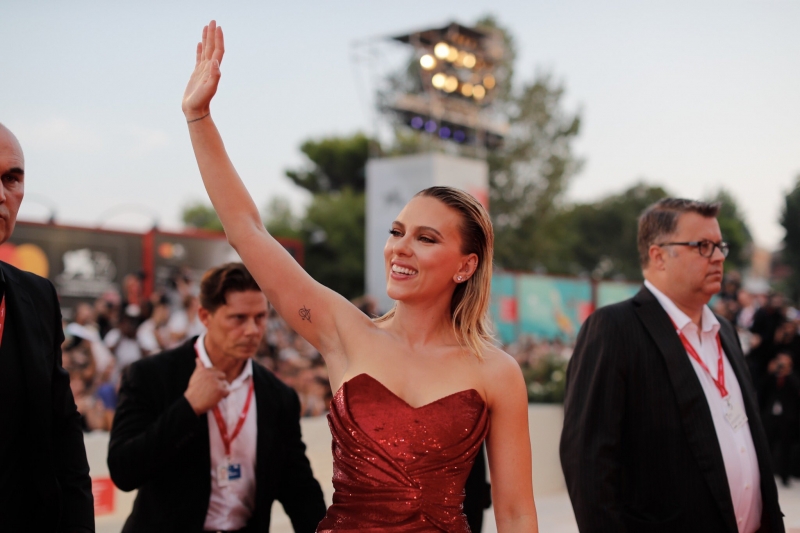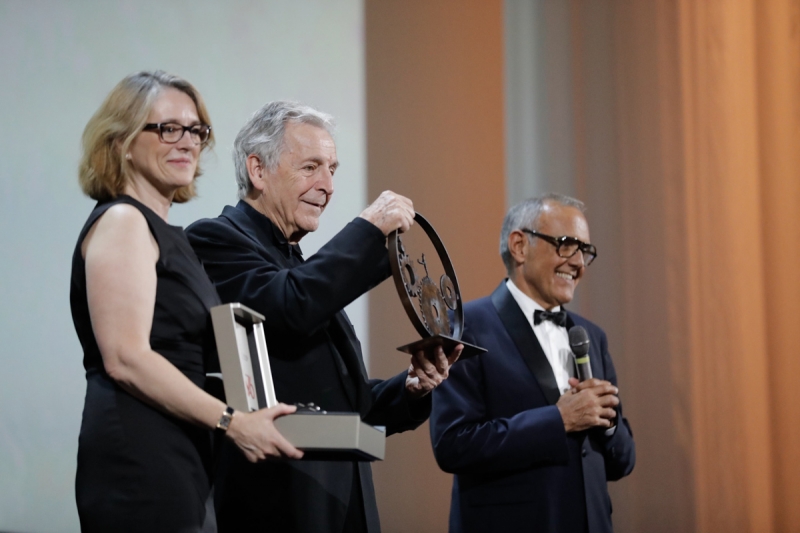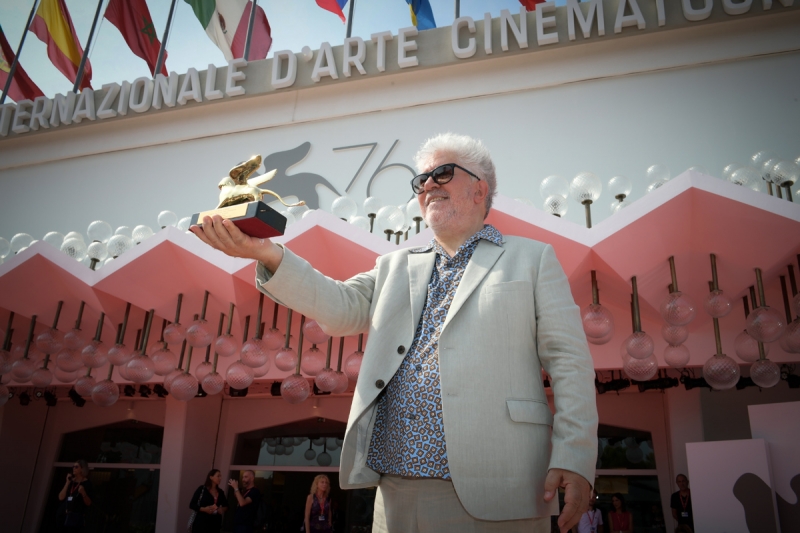|
|
||
|
Pro Tools
FILMFESTIVALS | 24/7 world wide coverageWelcome ! Enjoy the best of both worlds: Film & Festival News, exploring the best of the film festivals community. Launched in 1995, relentlessly connecting films to festivals, documenting and promoting festivals worldwide. Sorry for the interruption, we needed to correct and upgrade some modules. Working on a new website. For collaboration, editorial contributions, or publicity, please send us an email here. You need for put your full detail information if you want to be considered seriously. Thanks for understanding. User login |
Mostra Internazionale d Arte Cinematografica Venice
The 79th Venice International Film Festival will run from August 31 toSeptember 10, 2022. #VeniceProductionBridge, #BiennaleCinema2020 Photo Gallery with 450 ambiance pictures English I French  Special Orrizonti jury prize to problematic 'Caniba' at Venice
The special jury prize in the Orrizonti section of the 74th Venice Film Festival was awarded to Caniba directed by Lucien Castaing-Taylor and Véréna Paravel. The film debuted on September 4. The filmmakers allege that they employ “a decentered, nonanthropocentric approach to the visual practice of the moving image". Further, "their camera does not focus primarily on humans as privileged actors in the world but rather on the fabric of affective relations among the natural elements, animals, technology, and our physical lifeworlds.” Though this sounds impressive, their subject matter is one that has been medialized and fetishized since the 1980’s in numerous films and interviews, and hundreds of photographs, articles and publications. In 1981, a Japanese graduate student was rejected by a Dutch woman who was his colleague. He then murdered and raped her, and ate parts of her body. After a brief incarceration, Issei Sagawa signed himself out of the mental ward of a French hospital and returned home to Japan where he supported himself by writing manga and acting in cooking shows and pornographic films. His murder made him a celebrity. Images of the compartmentalization and atrophy of the female body have been historially exploited since early cinema. Sagawa's manga are graphic illustrations of female bodily functions and body parts of his murdered colleague. The filmmakers “nonanthromorphic approach” involves an excessive use of close-ups of Issei and his brother Jun, often out of focus, often obscured by unknown objects in front of the camera. Long shots and medium shots in focus with a synchronous soundtrack on a camera with a tripod customary in documentary work is absent. There are no questions, at least on camera, to the Sagawas. It has been claimed that D.W. Griffith first used the close-up in order to bring the face of a beautiful woman really close to the spectator (himself); this technique has been used to fetishize the female body for ethereal consumption; to provide materiality to the hidden meaning of a beautiful woman, an attempt to examine her interior, an impossible feat. The extreme close-up is the recurrent focal length used in Caniba. Its use differs from the exploitative interviews and documentaries on Sagawa, where the real subject is absent - the murdered , cannibalized body of a young woman, a victim of sexualized violence, clinically obscured by the filmmakers "nonanthropomorphic approach". Issei’s face is repeatedly colonized by the filmmakers, amd the sounds of mastication as he munches on a pastry or slurps up a drink. This draws attention to his cannibalism more than the detached photographs of his female victim in the public domain. Sound is the “affective domain” of the film - as food is ground down or sucked into soft material for digestion. The sounds create emotional reaction because we already know that Issei is a cannibal, and this knowlege makes him 'the actor' in this film. It is not entirely accurate that Castaing-Taylor and Paravel's filmmaking posture is non-anthropomorphic or even neutral because of their choice of the extreme close-up. This is used not only on Issei but Jun. While leafing through Issei's manga on the woman he murdered, we hear Jun chuckle over nearly every image. He states they are too much, too violent and then chuckles. There are frequent close-ups of Issei's face wth the soundtrack of Jun's chuckle. There is also a woman dressed in a maid’s outfit who feeds Issei an éclair. The sounds of his smacking and chewing accompany extreme close-ups of the woman, and her chuckling is similar to Jun's. Jun is shot in close-up during a performance involving self-mutilation. He is shown stretching barbed wire over his back, stabbing his arm with a steel comb, accompanied by chuckles. Issei is worried what will happen to him if his brother is gone. Both brothers are shown in black and white home movies as young children. A doctor listens to their chests with a stethoscope. Each is given a shot. Issei barely reacts, whereas Jun's face expresses agony. We learn that their mother had a miscarriage and that one of the boys saw her bodily fluids seep through her body. We see them dressed in costume, Sagawa wearing a bishop's mitre. Every technical choice of the filmmakers has ideological significance. Issei is the center, and his body and bodily functions are on display. He reveals his fetishizing of white women, of Grace Kelley, of his victim is who he calls by name. We see him actively working in an industry that commodifies women with excerpts from his films, with pixelated body parts. The films in the Orrizzonti section, including several excellent films from Iran, use actors. Caniba's filmmakers claim their work avoids privileged actors. This is inaccurate. The Sagawa brother are privileged actors within highly mediated industries. As actors, their appearances have been and are continually commodified. Issei Sagawa is known as “The Celebrity Cannibal. Caniba has now garnished a prize that will bring the filmmakers currency for future work, financed by Harvard University at "The Sensory Ethnography Lab" where Castaing-Taylor is the director. The Palme d’Or won by Swedish director Ruben Östlund at Cannes in May, “The Square”, concerns the art world and its commodification. The curator of a state museum selects artworks based on abstractions written by the creators of the work. “The Square” is described as a space where "care and love can be experienced" in a safe place and commissioned by the museum. The simulated execution of a child in a square, a performance that is broadcast on YouTube, is contracted to provide publicity for the show. Issei Sagawa’s image is in the public domain as well as photographs of the body of the woman he murdered. The filmmakers do not judge him, hold him ethically or morally responsible, but they do study his mind, and explore his actions where he and his brother are given agency through the cinematic apparatus. The filmmakers display a celebrity, his brother, his playmate and found footage of his family through blurry close-ups and skewed camera angles and tracking shots. These choices do not separate them from the materiality of their subject, and are impacted by an "anthropomorphic" core. The fallacy of Cabina is its blurred ideological premises rather than its oft publicized subject. In the end, Lucien Castaing-Taylor and Véréna Paravel have succeeded in making a "spectacle" of a man by going against the grain of their ambitions.
Moira Sullivan FIPRESCI, Alliance of Women Journalists FILMFESTIVALS.COM |
LinksThe Bulletin Board > The Bulletin Board Blog Following News Interview with EFM (Berlin) Director
Interview with IFTA Chairman (AFM)
Interview with Cannes Marche du Film Director
Filmfestivals.com dailies live coverage from > Live from India
Useful links for the indies: > Big files transfer
+ SUBSCRIBE to the weekly Newsletter DealsUser imagesAbout Mostra Internazionale d Arte Cinematografica Venice Oldest festival in the world, MOSTRA is Non-specialised competitive event for features and shorts. Two competing sections and three Prizes: the Golden Lion, the Lion of the Year and the Lion of the Future to best director`s debut film. View my profile Send me a message The EditorUser contributions |






























